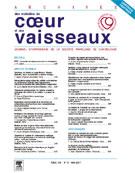06-51 - RIGHT VENTRICULAR FUNCTION ASSESSED BY TISSUE DOPPLER ECHOCARDIOGRAPHY IN PATIENTS WITH ARRHYTHMOGENIC RIGHT VENTRICULAR CARDIOMYOPATHY - 09/04/08
Gaelle Grezis-Soulié,
Fabrice Bauer,
Damien Brunet,
Mathieu Lemercier,
Frédéric Anselme,
Jean Nicolas Dacher,
Alain Cribier
Voir les affiliationsObjectives: Arrythmogenic right ventricular cardipmyopathy (ARVC) is a inherited disease characterized by progressive fibrofatty replacement of the right ventricle. The diagnosis of ARVC remains a challenge for clinicians. We performed this study to test the hypothesis that tissue Doppler imaging (TDI) and strain imaging (SI) might disclose RV dysfunction in patients with ARVC better than conventional echocardiography in patients with ARVC.
Material and Methods: Twenty-two patients meeting both Task Force and cardiac MRI criteria for ARVC were compared to 15 healthy controls. The right ventricle with imaged using M-mode, conventional and tissue Doppler echocardiography. We measured peak systolic and diastolic velocities, peak systolic strain rate imaging along with isovolumic times at tricuspid annulus and RV free wall.
Results: As compared to controls, patients with ARVC had significant lower peak systolic tricuspid annular and RV free wall basal segment velocities (8.0 ± 3.3 vs. 11.3 ± 2.2 cm/s, p < 0.005 and 8.2 ± 2.9 vs. 10.1 ± 1.6 cm/s, p < 0.05, respectively). Peak early diastolic RV free wall mid- and apical segments velocities were statistically decreased in patients with ARVC as compared to controls (6.1 ± 3.0 vs 8.3 ± 2.6 cm/s, p < 0.05 and 3.6 ± 1.5 vs. 6.1 ± 1.7 cm/s, p < 0.005, respectively). Peak late diastolic velocities are illustrated in figure. The isovolumic relaxation time of diseased heart was significantly prolonged in all RV segments (92 ± 42 vs. 55 ± 17 ms at tricuspid annulus, 92 ± 45 vs. 56 ± 19ms in the basal segment, 113 ± 45 ms vs. ….. in the mid-segment and 121 ± 39 vs. 50 ± 17ms in the apical segment, p < 0.005). Deterioration of isovolumic contraction time was only visible in the RV free wall mid- and apical segments (96 ± 37 vs. 78 ± 28ms and 92 ± 39 vs. 74 ± 21ms, p < 0.05, respectively). We also found a significant reduction in systolic peak strain rate RV free wall measurements (2.2 ± 1.5 vs 3.2 ± 1.2/s, 1.7 ± 1.3 vs 2.8 ± 1.0/s and 1.1 ± 0.9 vs 2.5 ± 1.0/s, p < 0.005 in basal, mid and apical segments, respectively)
Conclusion: Diffuse amplitude and phase regional diastolic dysfunction is found in patients with ARVC while regional systolic abnormalities are more disparrate.

© 2007 Elsevier Masson SAS. Tous droits réservés.
Vol 100 - N° 12
P. 1085 - décembre 2007 Retour au numéroBienvenue sur EM-consulte, la référence des professionnels de santé.

